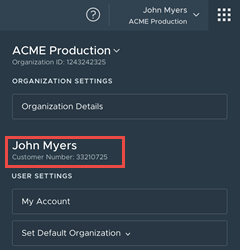If you are an organization owner with a federated account, you still need to have a VMware ID linked to your corporate account.
Why Can't I See All My Services?
You must link your VMware ID account to your federated account so that you can access all the services from your VMware ID account. If you have any tokens, they will automatically be transferred.
How Do I Link My Account?
Link your account by clicking on the Cloud Services Console.
If you used your corporate email address when you created your VMware ID, click the Link VMware ID button in the Cloud Services Console banner. If you close the banner before linking your account, you can link your account later by clicking on the Cloud Services Console.
You can view the details of your linked account in the Profile page.
How Does This Impact Organization Owners?
If you are an organization owner, you must link your VMware ID account. After you link your account, you'll receive a customer number. Going forward, when you create a new organization, you'll link your VMware ID account as you set up the organization.
Where Do I View My Customer Number?
As an organization owner or a support user, you require a customer number. After you link your account, your customer number appears under your name on the User/Organization Settings menu.

You can also view your customer number and other details of your linked account on the Profile page.
What happens to my OAuth clients
OAuth clients are used to integrate third-party applications with VMware Cloud services.
In cases where the user name of your federated account is the same as your VMware ID, for example [email protected], any OAuth clients you created while logged in with your VMware ID, will be transferred to your federated account when you link your VMware ID.
If the user name of your VMware ID is not the same as your federated account, for example, [email protected] and [email protected], your clients are not transferred to your federated account, and you should create new clients.
For more information about creating OAuth clients, see Authenticating Your Applications with OAuth 2.0.